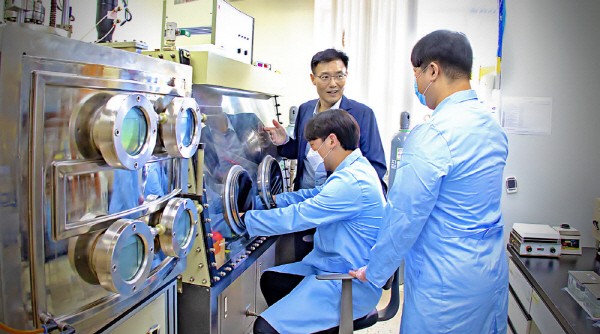Kyung Hee University Display Research Center, Nano Material Source Technology Development Project Results
A Korean research team has developed a new technology to solve the 'blue light leakage' problem, a chronic problem in quantum dot (QD) displays. At the same time, it is expected to reduce costs when commercialized, since it can achieve high luminescence by increasing light conversion efficiency and reducing manufacturing processesfor QD displays.

The joint research team at Kyunghee University's Display Research Center announced on the 5th that they have developed a vapor deposition method (aerosol) that simultaneously forms QD and metal oxide in a thin film form, using a technology that overcomes the limitations of inkjet QD display process technology. Using this technology, it is possible to completely block blue light leakage and increase the light conversion efficiency by 40% with only a three-micron light conversion layer, which is about a third of the thickness of existing ones.
QD displays that use blue organic matter as light-emitting materials are mainly manufactured by inkjet printing. It is a form of printing red and green QD materials like ink on blue OLED substrates. When implementing a QD displayon a large-area, there may be light leakage problems due to strong blue light. Blue light penetrates the red and green material layers and interferes with vivid color.
If the red/green QD photoconversion material layer is thickened up to 11 microns, blue light leakage can be prevented. However, the only problem is, a color filter must be introduced because it cannot completely block blue light leakage. This leads to an increase in cost as the number of steps in the process grows and the material consumed increases.
The research team implemented the QD layer with an aerosol method that sprays fine particles by mixing metal oxides such as silicon oxide and aluminum oxide in the QD light conversion material layer. As a result, blue light leakage was prevented even with a thickness of 3 microns. This means the material efficiency has increased by more than 60% compared to previous ones. It is expected that the number of steps in the process will reduce when commercialized.
It induces diffuse reflection of blue light inside the QD layer and greatly improves the conversionefficiencyof red and green light. As a result of the simulation, the light conversion efficiency was improved by 37.4% for red and 42.4% for green. The research team explains that red and green lightsareshown to more brightly.

Jong-wook Park, head of the research center (Professor at Kyunghee University) who led the development of this technology, said, “It is a technology that can be used not only for perovskite QD displays, which are attracting a lot of attention as next-generation displays, but also for QD OLEDs.”
The results of the study were published in the 'Chemical Engineering Journal', a renowned academic journal in the field of chemical engineering processes. It received high evaluations, in the top 2.45% of the Journal Impact Index (JCR ratio), and a citation index of 13.27.
The study was conducted through the university-focused research institute project and the nanomaterial source technology development project. Major universities such as Kyunghee University, Ajou University, and KAIST participated in the study. The research center is expanding the research base for next-generation displays, including not only QD display technology but also human-friendly high-performance displays. Director Park said, “The R&D center will secure next-generation display materials and device source technologies and lead the revitalization of the domestic display industry, with the participation of large domestic companies as well as small and medium-sized companies, and joint research with major overseas research institutes," said Director Park. "We will realize our vision of future eco-friendly displays withour team of excellent research personnel."
By staff reporter Dong-jun Kwon (djkwon@etnews.com)